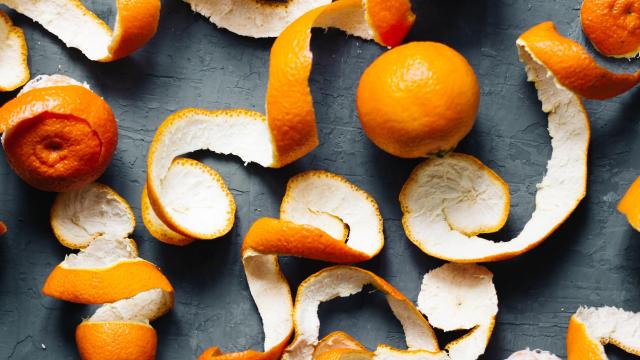In addition to being a delicious and portable snack, oranges — or more specifically, their peels — have a second life as everything from candy, to pest control in your garden, to an egg cooker. They also come in handy for keeping your kitchen clean and smelling fresh.
Whether you want to decrease the amount of food waste you produce, cut costs and/or the use of chemicals when you clean, or simply love the scent of citrus, here are a few ways to use orange peels to clean your kitchen.
Make a DIY cleaning spray
Every kitchen needs an all-purpose cleaning spray to tackle everything from greasy counters to grimy sinks, and this one made using orange peels gets those jobs done, and more. Here’s how to make it, according to a previous Lifehacker article:
All you need to make your own cleaner is a few leftover citrus peels from oranges (or clementines), distilled white vinegar, and a little water. Simply fill up an airtight container with the peels, cover them with white vinegar, and wait two weeks. After that, you can strain out the peels, dilute the mixture with water, and dump it into a spray bottle.
Clean and deodorise your garbage disposal
Given what they do, it’s hardly surprising that garbage disposals can, on occasion, emit a foul odor. To get rid of the bad smell, dump a large bowl of ice cubes and one cup of orange (or other citrus fruit) peels into your garbage disposal, then turn on the cold water and the disposal, and run both for 30 to 45 seconds. After that, turn them off and run hot water for 15 seconds.
Make a DIY cleaning scrub
Take on stubborn spills and greasy spots on your counters, tile, or in your sink with this DIY cleanser. It uses orange zest rather than whole peels, so that means you have to remember to zest the orange before you eat it.
Once you have the zest of a few citrus fruits (feel free to combine oranges, lemons, limes, grapefruits, etc.), spread it onto a baking sheet, and put in the oven (or toaster oven) at 75°C for 45 minutes, breaking up any clumps of zest every 15 minutes. Then, turn the dehydrated zest into a powder using a blender, food processor, coffee or spice grinder, or mortar and pestle.
Next, put the following into a clean glass jar:
- 1 to 2 tablespoons ground-dried citrus zest
- ½ cup baking soda
- ¼ cup salt
- ¼ cup washing soda
Shake the everything in the jar to combine the ingredients. To use the cleanser, sprinkle it on the grimy surface, then scrub using a damp sponge or rag, or an old toothbrush for tougher messes. Rinse the area when you’re done.

Leave a Reply
You must be logged in to post a comment.